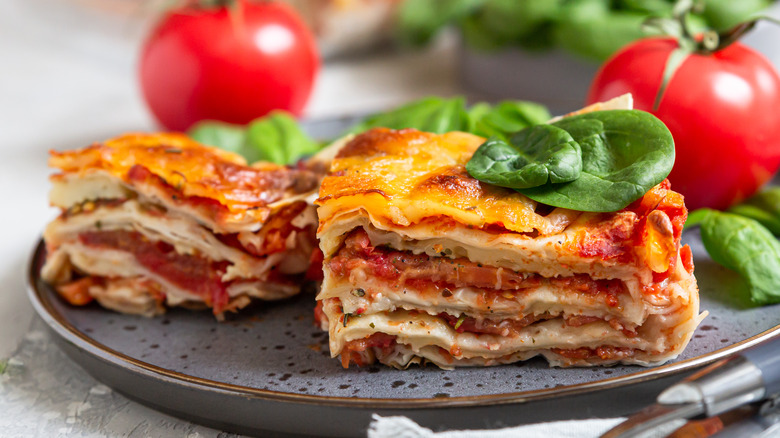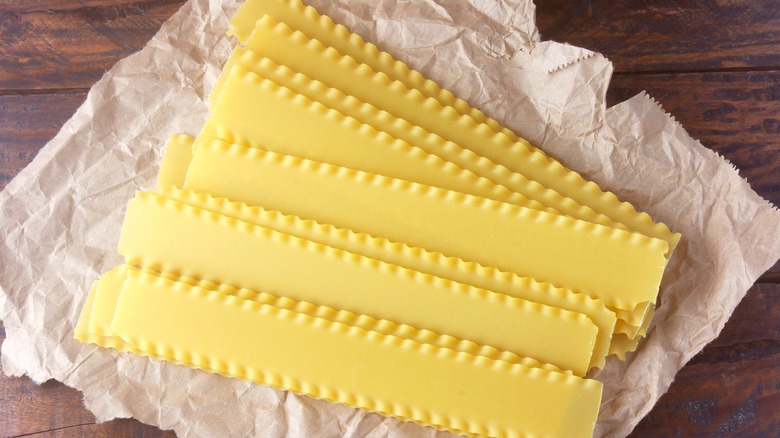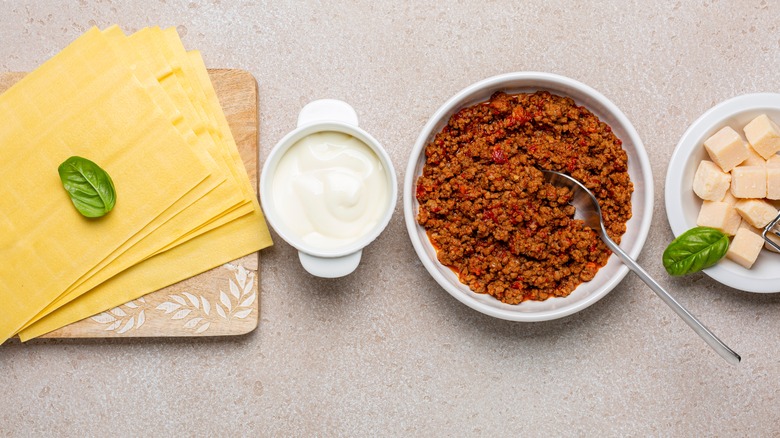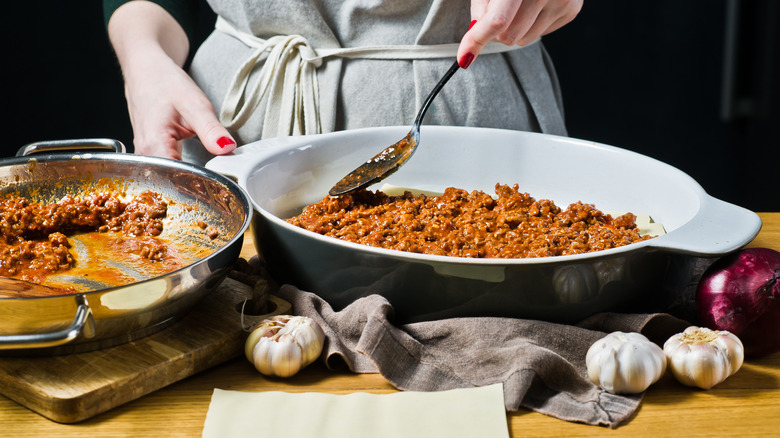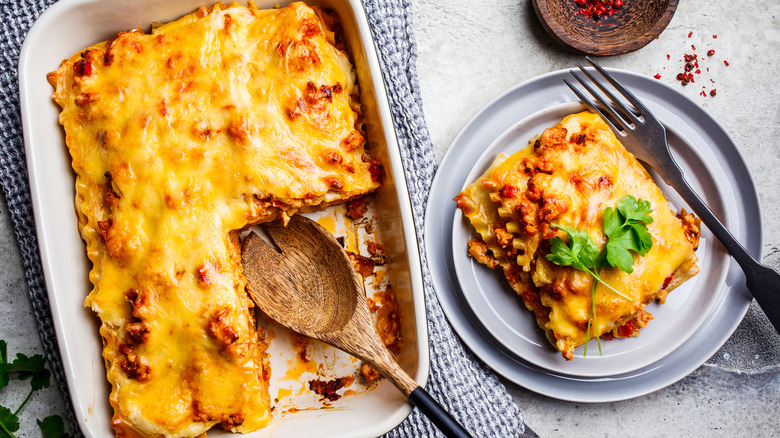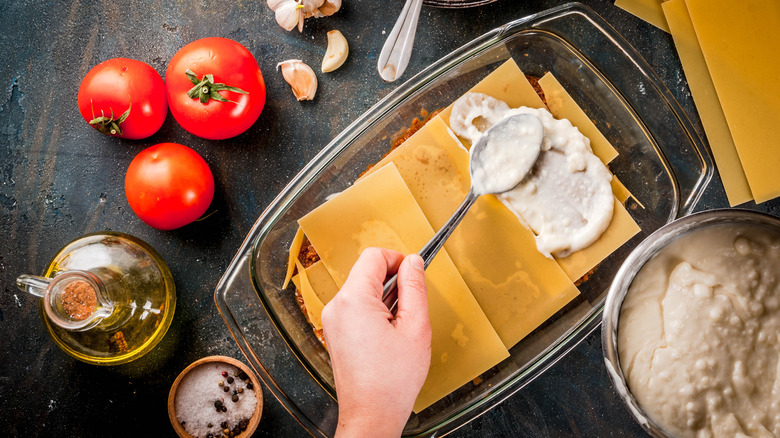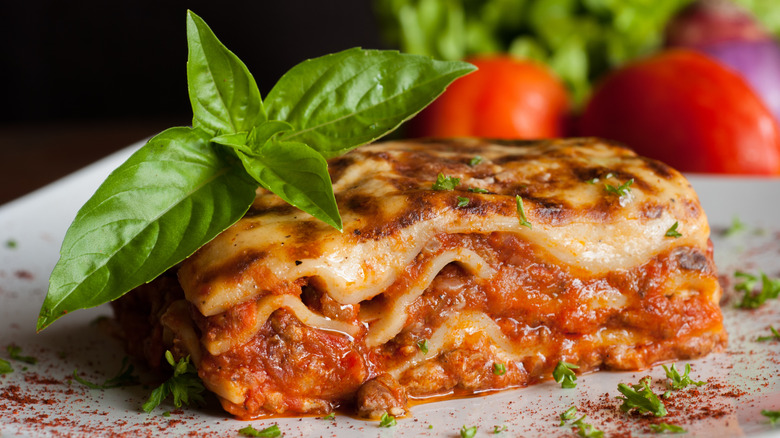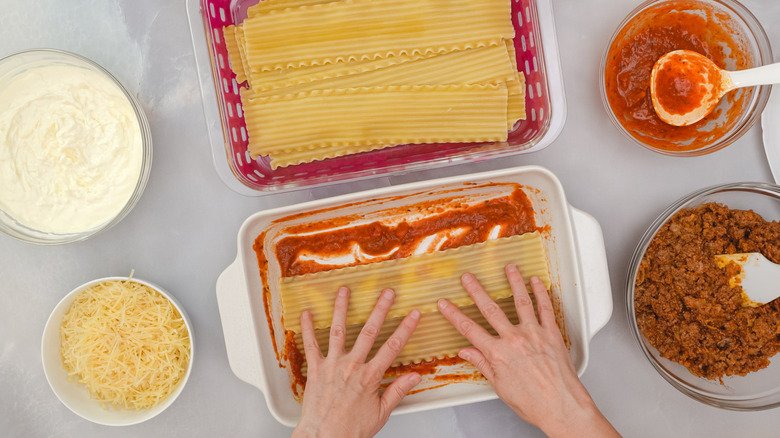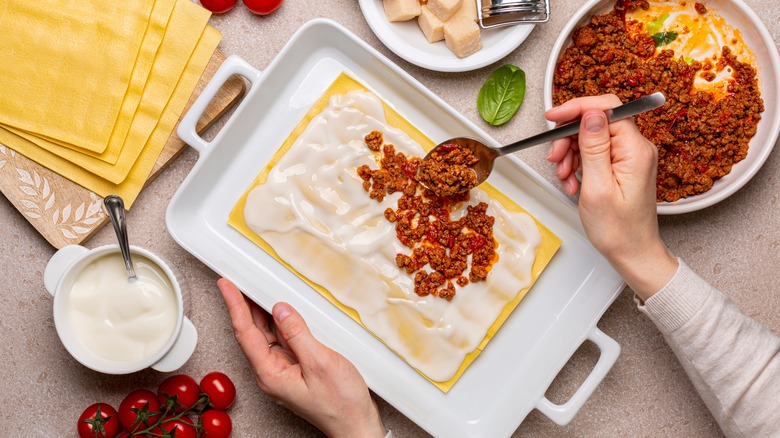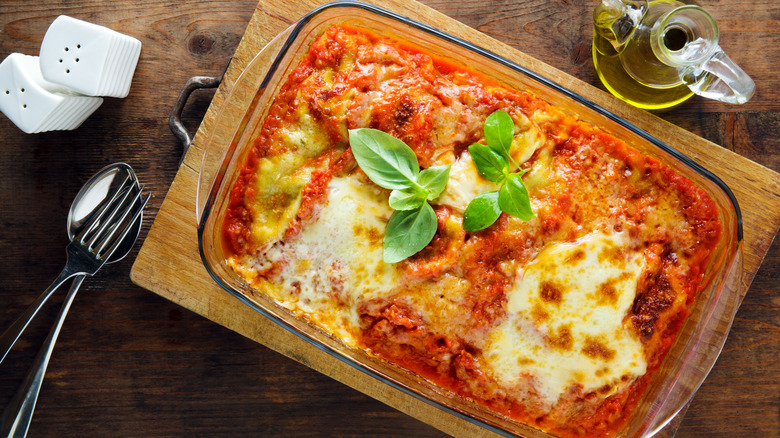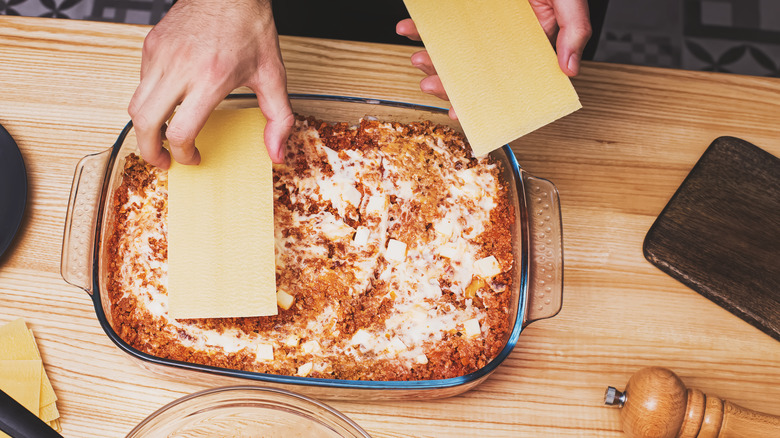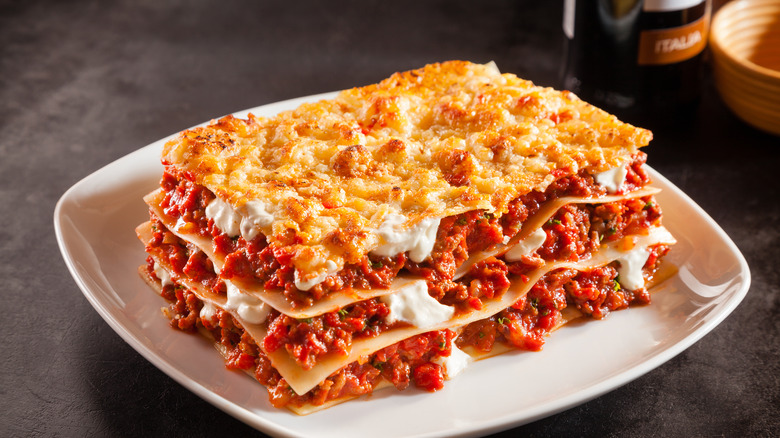12 Lasagna Mistakes You Didn't Realize You Were Making
Ah, the beloved lasagna, the queen of casseroles. Lasagna is a classic Italian dish that is enjoyed by many around the world. The layers of pasta, tomato sauce, cheese, and meat make for a hearty and satisfying meal that is perfect for feeding a crowd or for a cozy family dinner. However, cooking lasagna can be a bit challenging, and despite its popularity, some still struggle to make a flawless bite. Mistakes can happen through every step of the cooking process.
From burnt edges and undercooked noodles to using the wrong pot and ingredients, lasagna can be a finicky dish to get just right. Even using the wrong amount of sauce or type of cheese can affect both the flavor and texture. So, if you are tired of serving up a lasagna that's more mush than magic or that's as dry as the Sahara, we have the lowdown on what not to do, and how to get it right. A well-made lasagna can be a delicious and satisfying meal, just as long as it's cooked correctly.
1. Not cooking the noodles correctly
If you've ever made lasagna before, you know that the noodles can be one of the trickiest components to get correct. Overcook them, and they turn into a mushy mess. Undercook them, and they can be chewy and tough. It can be a real challenge to achieve that perfect al dente texture that makes lasagna truly delicious. But why does cooking lasagna noodles correctly matter so much? Well, the noodles are a fundamental building block of the dish, and they play a key role in the texture and overall success of the final product. When cooked properly, they should be tender and slightly chewy, with just enough firmness to hold up to the layers of sauce, meat, and cheese. You want to avoid noodles that are tough and difficult to eat.
To do so, begin by choosing the type of noodle, oven ready or wavy. Wavy lasagna noodles are the traditional type of long, flat pasta used in this dish, and they are great for holding all the components together with their rigid ends. They are typically boiled before they can be used. Oven-ready noodles are a more recent development and are a great option for those home chefs looking to save some time in the kitchen. Unlike wavy, these noodles do not need to be boiled before use, as they cook during the baking process. This means you can assemble your lasagna layers more quickly and easily, without having to worry about boiling and draining the noodles first.
Which type of noodle to use is a personal preference and boils down to how much time you have to spend in the kitchen and which type you have on hand in the pantry.
2. Not having all the ingredients ready
Have you ever found yourself halfway through making a delicious lasagna, only to realize that you're missing a crucial ingredient? Or perhaps you started to cook the meat sauce, only to realize that you forgot to chop the onions and garlic beforehand? These kinds of mistakes can be frustrating and can lead to a less-than-perfect final dish. Being prepared is key to a successful lasagna. That means having all your ingredients ready before you begin layering. Think "mise en place" — in other words, put "everything in its place." The term refers to the practice of preparing and organizing all of your ingredients before you begin cooking.
When it comes to cooking lasagna, this step is especially important. Lasagna is a dish that requires several different components and ingredients that need to be added and layered at different times during the cooking process. By taking the time to properly prepare and organize your ingredients before you start cooking or constructing the layers, you can ensure that the process goes smoothly and that your dish turns out perfect. Plus, you will make sure you are not missing any vital ingredients or seasonings. In the long run, it can even save you time, as you won't have to stop and search for ingredients or measure things out while you're in the middle of cooking. Avoid frustration and a lousy lasagna and practice preparing all the ingredients before you begin.
3. Not browning the meat
One of the biggest mistakes people make when cooking a homemade lasagna is not browning the meat beforehand. Some people may skip this step in an attempt to save time or because they think it's not necessary, but browning the meat first is essential in making a delicious and properly cooked lasagna. Although lasagna is a dish that typically bakes in the oven for a relatively long time, raw meat may not cook all the way through during this time frame. When you brown meat, you caramelize its natural sugars and guarantee it's fully cooked. This process helps to create a deep and rich flavor that is otherwise not present in raw meat. Browning the meat can also help to remove excess moisture. If you do not brown the meat first, the moisture can leak out during the cooking process and make the final dish watery.
Properly cooking the meat before layering is also important from a food safety standpoint. It helps to kill any harmful bacteria that may be present, reducing the risk of foodborne illness. Make sure the pan is the right temperature before dropping in the protein. Once the pan is ready, you will want to cook the meat until it reaches a temperature of 160 degrees Fahrenheit everywhere, per the USDA. Don't forget to season the meat as it browns. This allows time for the spices such as black pepper, salt, garlic powder, onion powder, Italian seasoning, or any other herbs and spices that you prefer to infuse, adding another layer of flavor to the lasagna.
4. Using the wrong cheese
Not all cheese is created equal, especially when it comes to lasagna. Different types of cheese have different characteristics, and some may work better than others. How they melt, how they taste, and how they interact with the other ingredients in the lasagna are important to note. Using the wrong cheese in the classic pasta recipe can have a significant impact on the final texture and taste. Whether they know it or not, some people may choose a cheese that doesn't melt well, such as a feta or queso fresco, which can result in a grainy or lumpy texture. Others may use a cheese that is too mild, such as Swiss or provolone, which can result in a less flavorful lasagna. A good cheese to use is one that melts well and has a strong flavor that can stand up to the other ingredients in the dish.
Fresh mozzarella is best due to its taste and texture. This staple ingredient is a mild, versatile cheese that melts effortlessly and can help create a delicious, gooey texture in a lasagna dish. It can be used shredded or sliced and is usually layered in between the noodles and other ingredients, as well as on top of the lasagna to create a cheesy, golden brown crust. It is typically used in combination with other types of cheese for a richer, creamier texture. Some of these other cheeses include ricotta, Parmesan, Pecorino Romano, and, if you're feeling really fancy, fontina. Using the right cheese, or cheeses, in the right amount, can help create a well-rounded, balanced flavor for your next lasagna recipe.
5. Skipping the dairy sauce
Dairy sauce or, béchamel sauce, is a staple in French cuisine, and it is also critical for a deliciously tasty lasagna. If your layered entrée is lacking something, this is the likely component. The dairy sauce in this culinary masterpiece is typically a white mixture made from a combination of butter, flour, and milk.
To make a béchamel sauce, start by melting butter in a saucepan and then whisking in an equal amount of flour to create a roux. As you stir these two ingredients together, you gradually whisk in warm milk, stirring constantly to prevent lumps from forming. As this mixture simmers over heat, it thickens to a creamy consistency. It is typically seasoned with salt, pepper, and other spices to add another level of flavor to the lasagna layers. There are some recipes that may also call for the addition of grated Parmesan cheese, which can add a nutty, salty flavor to the white sauce. Others add chicken stock or broth for increased flavor.
If this is the first you're hearing of this concoction, odds are you've been skipping it, and your lasagna and taste buds have paid the price. Next time, don't make this same mistake, as it's this very component that helps bind the layers of the lasagna together, and it can also help to keep the lasagna from drying out during baking. Without the white sauce, the lasagna may be dry and crumbly, making it difficult to cut and serve.
6. Skimping on the amount of marinara
Now that you have the white sauce down, it's time for the red sauce. Odds are, you never miss this step, but you may be making a critical mistake when measuring. If you skimp on the amount of marinara sauce in each layer, the noodles may come out too crispy and the meat too dry. The marinara sauce is what helps keep the cheese and noodle layers moist during baking, and adding the right amount is important to a successful casserole.
How much marinara sauce do you add? A general guideline is to use about 2 to 3 cups of sauce for a standard 9-inch by 13-inch lasagna pan. However, the exact amount of sauce can vary depending on factors such as the size of the lasagna pan you are using, the number of layers in the lasagna, and the amount of other ingredients. It's also important to spread it evenly over each layer of noodles, making sure to coat the pan corner to corner. As you spread, be generous, accounting for the noodles absorbing some of the mixture.
Whether you're cooking your own sauce or using a jarred variety, ensure it's not too thick or too thin. If the sauce is too thick, you can thin it out with a little water or chicken broth. If it's too thin, you can simmer it for a few minutes to thicken it up. It's also a good idea to taste and adjust the seasonings for the sauce as needed before adding it into the lasagna. Just in case, have some extra sauce ready if your lasagna comes out too dry.
7. Improperly layering the noodles
Layering lasagna noodles is a key step in making a delicious and visually appealing dish. Improperly layering them can be a costly mistake that can ruin the whole entrée. Not only can this be frustrating, but it can also be a waste of time and money, especially if you have to throw the entire dish away and start again. The noodles must be placed in the baking dish in a way that supports each layer of meat and cheese.
Regardless of which type of lasagna noodle you use, wavy or oven ready, you want to use enough noodles to cover the entire bottom of the pan. As you place the noodles in the baking pan, lay them down lengthwise, leaving no gaps between them where sauce or meat could fall through. Think of the noodles as a blanket to wrap all the other ingredients and try to slightly overlap them. This technique allows you to make the most of the available space in your baking dish and also makes it easier to cut and serve the lasagna without the layers falling apart. When the noodles are aligned in the same direction, you can easily slice through them to create a neat, evenly portioned piece that holds together well.
If necessary, you can even trim the noodles to fit your dish and make sure the entire bottom is covered completely. If you overlap the noodles too much, you may have to use more noodles and filling than the recipe calls for and run the risk of undercooked noodles. If you don't overlap the noodles enough, you may end up with gaps between the layers, which can make the lasagna dry, hard to cut, and unappetizing.
8. Forgetting a layer of sauce
Before you even place a noodle in the baking dish, there's a step you may be skipping, resulting in a crusty bottom layer when the lasagna is finally done baking. Lasagna noodles have a tendency to stick to surfaces and become dry and crispy, particularly when they're cooked for an extended period of time at high temperatures. You may have experience burning a lasagna or two or simply want to prevent this from happening — either way, you won't want to skip this important step next time you are responsible for cooking dinner.
No, it's not coating the pan in cooking spray or butter. Adding sauce to the bottom of the pan when baking a lasagna in the oven is an important step that many people overlook. The sauce not only adds flavor but also serves a practical purpose by creating a barrier that prevents the noodles from sticking to the bottom of the baking dish and burning. This layer of moisture keeps the bottom layer of noodles tender and flavorful as the casserole of meat, cheese, and pasta cooks. The base layer of sauce will also help to distribute heat more evenly as the lasagna bakes. You want to see it bubbling in the oven! Just a few spoonfuls of sauce will do; you don't want to overload the base, as all liquid will pool here.
9. Using the wrong pan
Noodles? Check. Sauces? Check. Meat? Check. Cooking a delicious lasagna requires more than just following the right recipe, though. Choosing the right type of pan to cook the lasagna is just as important as selecting the correct ingredients and following the proper cooking methods or instructions. The right type of pan will ensure that the lasagna cooks evenly and comes out of the oven looking and tasting its absolute best. This decision can affect the texture, flavor, and appearance of the finished dish.
Not just any dish will do. Firstly, determining the right pan size for your lasagna recipe depends on the number of servings you need to prepare and the recipe itself. Check to see how many servings your recipe makes and then select the baking dish. A standard lasagna pan typically measures 9 by 13 inches, but you may need a larger or smaller one depending on your guest list or desire for leftovers. When it comes to shape, rectangular or round pans will work. Also, the depth of the pan is important because it will affect the number of layers you can add to the lasagna. A deeper pan will allow for more layers, while a shallower one will limit them. As for material, when it comes to this classic casserole, glass or ceramic are preferred, as they're typically best for crustless dishes. Always check your cookware before use. Most glass bakeware is labeled "oven safe," but some varieties can only be heated to temperatures of 400 degrees Fahrenheit.
10. Not making enough
Not making enough lasagna is a mistake some home cooks will inevitably make for various reasons. Whether out of lack of experience, fear of food waste, or not having enough ingredients, this is a lasagna baking mistake you definitely want to avoid. Making enough lasagna for you and any guests isn't easy. It requires some planning and preparation ahead of time, beginning with gauging how much of each ingredient you actually need. It's easy to underestimate the amount of food for a group, family get-together, or even just yourself.
So how much lasagna do you need? It depends on the number of guests expected and how much of the dish you will need to feed them. Take into consideration the average appetite and whether leftovers are desired. You want to make sure you have browned enough meat and have plenty of cheese and sauce to complete every layer for your dish and amount of people. If in doubt, it's better to make a bit more lasagna than to not have enough — this is a great dish to be reheated or frozen for another meal on another day. As a rule of thumb, choose a medium-sized pan that typically serves about eight people. If using a smaller pan for individual servings, make sure you adjust the recipe ingredients.
11. Not protecting the top layer while baking
A common problem many people face when cooking lasagna at home is burning the top of the lasagna. When the dish is directly exposed to the heat, it can become really dry and even burnt during the baking process. This can be disappointing and detract from the overall flavor and texture of the ditch. Not protecting the lasagna is a mistake home cooks often make. Before sliding it in the oven to bake, cover the top! Don't skip this step if you want to ensure that it stays moist and flavorful. How exactly do you protect the top layer of lasagna? There are a few simple tricks and techniques that can help.
If possible, you can use a lid to cover the baking dish or simply cover the top with foil. In this way, the top layer can be shielded from direct heat and will cook without crisping. For a perfectly browned lasagna, make sure to remove the covering at the right time during the baking process. When to do so is a bit of a debate. Results will vary, but the most common times to remove the covering for most home chefs are about halfway through baking, when the cheese is melted, or toward the very end, when the lasagna is almost done cooking. When the covering is removed will determine how browned the top layer will be when the dish is finished.
12. Thinking you only have to use ricotta cheese
Using ricotta cheese in a lasagna recipe is a traditional and popular choice, but it is not the only option. Many people believe that it's a key ingredient in lasagna because it adds a creamy texture and rich flavor to the dish. However, ricotta is not a requirement for lasagna. In fact, there are many variations of this Italian classic that do not include ricotta at all, such as a lasagna Bolognese, which typically uses just the béchamel sauce.
Ultimately, the choice to use ricotta in your lasagna recipe comes down to a personal preference and taste. Some people really love the creaminess and flavor that this cheese adds to the layers of the dish, while others prefer a totally different flavor profile. Other types of cheeses, such as asiago, can also be used to create a unique flavor and texture, as it delivers a nuttier profile. On the other hand, mixing and matching a few different types of cheese can create a truly unique layered bite.
You can always try experimenting with different lasagna ingredients and recipes as a great way to discover new and delicious variations of this classic Italian dish. At the end of the day, making mistakes is a natural part of the cooking process, and learning from these mistakes is key to becoming a better and more confident home cook.
Static Media owns and operates Daily Meal and Mashed.
